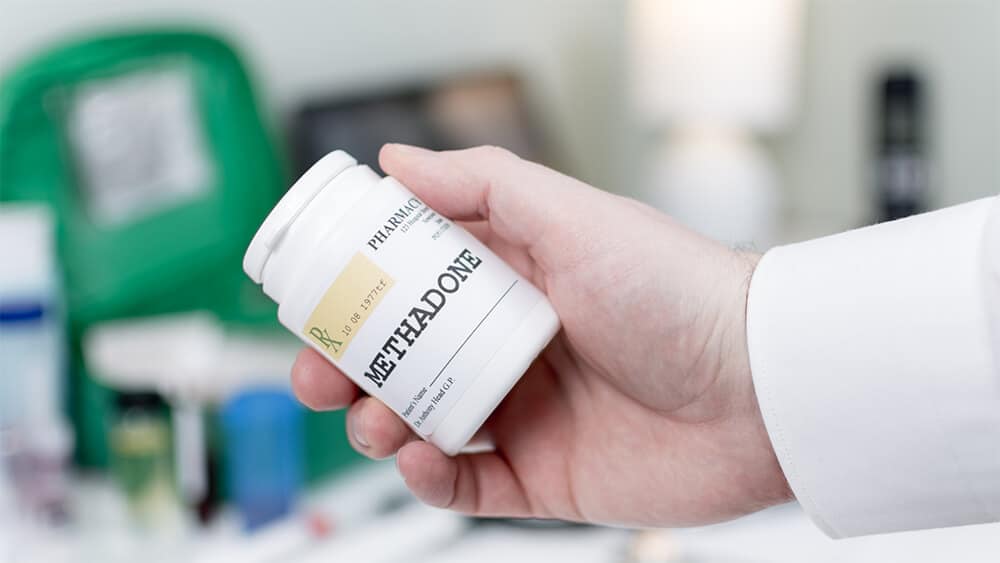Opioid addiction has become a difficult challenge to manage around the globe. The accessibility of opioid drugs, both legal and illegal, has led to a surge in addiction cases that have made this form of addiction particularly hard to contain. However, over the years, specific drugs have been designed to help support short- and long-term opioid addiction.
Suboxone® and methadone have become well-known for helping individuals suffering from their addictions safely and effectively detoxify and begin living everyday lives. However, while both of these drugs are similar in how they support addiction treatment, there are differences in how they work, their side effects, and how long it can take for individuals to break free from their addictive states.
Methadone Facts
What Is Methadone?
Methadone[1] is a medication primarily used for the maintenance treatment of opioid addiction but can also be prescribed for pain management. Unlike other opioid-based drugs like morphine or codeine, methadone is synthesized in a lab but interacts with the brain’s pain receptors in a similar way. Because of how it’s designed, Methadone typically has a longer duration of effect, which is one of the primary benefits of using it as a treatment for opioid addiction. Since methadone is longer-acting and is prescribed in controlled quantities, it can help stabilize the patient and reduce cravings and withdrawal symptoms associated with opioid addiction, including heroin and other opioids.
How Does Methadone Work?
Many times opioid addiction begins as a form of pain management but quickly becomes a physical and psychological dependence due to unregimented use or intentional abuse because of its euphoric properties. As a form of pain management, methadone works in a similar way as other opioids do by blocking pain receptors in the brain while producing sedative-like effects. However, because of its longer duration of effect, methadone creates a safe and effective environment for individuals to begin to wean off their addiction without suffering the sometimes intense withdrawal symptoms that occur with other opioid drugs.
Depending on the individual circumstances of someone battling opioid addiction, Methadone can be prescribed in different doses and cadences. The typical starting dose for methadone maintenance treatment is usually 10-30 mg daily. However, this will depend on whether the individual suffers mild or severe withdrawal symptoms or is on a strict maintenance schedule.
Benefits Of Methadone

Methadone treatment can offer various benefits to any individual suffering from mild or severe opioid addictions. These benefits include:
- Reduced Cravings: Because of its ability to manage pain effectively and in controlled doses, methadone helps to significantly reduce addictive cravings seen in other opioid drugs.
- Drug Stabilization: Methadone usage is carefully monitored by medical professionals under safe and controlled circumstances. This ensures the individual can stabilize their drug use in a secure and structured manner.
- Improved Quality Of Life: By allowing individuals to successfully wean off their use of uncontrolled opioid use, Methadone treatments help them to restore their physical and mental health in recovery while enabling them to return to their everyday lives.
- Lower Risk For Overdose: Methadone treatment has been proven to help individuals get past their addictions and helps to reduce the risk of overdose.
- Safer Alternative To Injections: Methadone can be taken orally in pill or liquid format, which is a much safer alternative for individuals used to inject opioids or share needles, reducing the risk of the transmission of HIV, hepatitis C, or other diseases.
Methadone Treatment Process
Before methadone treatment begins, a trained medical professional initially assesses a patient. During this process, the patient’s medical history, physical condition, and level of drug use are evaluated. After the assessment is complete, a treatment plan tailored to meet the individual’s needs is created. Treatment plans will consist of varying dosages of the drug over the course of the treatment period.
After some time, a maintenance or tapering schedule will be created to help the individual slowly wean off of their opioid addiction. This usually consists of a combination of counseling and medication, which can help them better manage their drug use and cope with any underlying psychological issues related to their addiction.
Side Effects and Health Risks of Methadone
Although methadone has proven effective when helping individuals suffering from opioid addiction, there are certain side effects and health risks associated with its use. These include:
- Sweating
- Dry Mouth
- Insomnia
- Weight Gain
- Drowsiness
- Nausea
- Rash and Itchy Skin
Suboxone® Facts
What Is Suboxone®?
Suboxone® is another medication intended to help individuals suffering from opioid addiction successfully wean themselves from the drugs. Suboxone® is actually a combination of two separate ingredients, buprenorphine[2] and naloxone. Similar to the effects of Methadone, Suboxone® helps to reduce the craving for opioids and is actively used in treatment plans for drug addiction recovery.
How Does Suboxone® Work?
Suboxone® is classified as a partial opioid agonist-antagonist, with buprenorphine being a partial opioid agonist and naloxone being an opioid antagonist. By blocking the receptors in the brain that respond to opioids, Suboxone® helps to reduce cravings and withdrawal symptoms so an individual can maintain sobriety. Naloxone, one of the ingredients found in Suboxone®, is an opioid antagonist known to reverse the effects of opioids when taken in high doses. This makes it a good choice for those with more severe addictions who need stronger medications to help them break a dangerous cycle.
Benefits Of Suboxone®
Methadone and Suboxone® have similar benefits when taken to help with addiction recovery. However, there are some specific circumstances where Suboxone® may be a better choice. Below are some of the benefits of taking Suboxone®:
- Lower Chance of Abuse: The buprenorphine in Suboxone® has a ceiling effect, limiting its ability to produce euphoria and respiratory depression at higher doses, thereby reducing the chances of abuse and overdose compared to full opioid agonists.
- Fewer Withdrawal Symptoms: Suboxone® is known to cause fewer withdrawal symptoms, making it much easier for individuals to transition off of opioids.
- Reduced Sedative Effects: Suboxone® does not have the same sedative effects that Methadone does, which can be beneficial for those who need to remain alert during the day.
- Higher Safety Levels: Methadone and Suboxone® have been proven to significantly reduce the likelihood of accidental overdose in opioid users.
Suboxone® Treatment Process
Unlike Methadone treatment, which can typically start while individuals still use opioids, Suboxone® treatments usually start during an induction phase where individuals are already in a mild to moderate withdrawal stage. While Methadone patients are typically required to visit OTPs (opioid treatment programs) to receive their treatments, Suboxone® can be administered in various healthcare settings, including primary care offices. Weaning off of Suboxone® is also considered to be slightly easier than methadone as it produces milder withdrawal symptoms.
Side Effects and Health Risks of Suboxone®
The side effects of Suboxone® are very similar to Methadone, with some minor differences. They include:
- Respiratory Depressing
- Swelling (Edema)
- Sleep Disturbances
- Sweating
- Headaches
- Constipation
Suboxone® Vs. Methadone
How They Compare In Length of Treatment
Suboxone® is typically taken for 12-24 months. Methadone is also used for long-term treatment, but the duration varies significantly from person to person, ranging from 6 months to several years based on individual circumstances. Both medications aim to break the cycle of addiction and help individuals regain control of their lives.
Differences In Withdrawal and Tapering Schedules
Suboxone® tapering schedules vary greatly and can range from 4 to 28 days or longer, often tailored to the individual’s needs and response to treatment. The intensity of symptoms can vary, but it’s generally a smoother process. Methadone, on the other hand, is known for more prolonged and intense withdrawal symptoms that can last weeks to months after the last dose. Tapering off methadone takes much more time and patience compared to Suboxone®; however, It’s important to note that everyone’s experience with these medications can be different.
Estimated Cost of Treatment
The cost of methadone and Suboxone® treatment is fairly similar, with some small differences. While Methadone treatment averages around $125 per week, the cost of Suboxone® can vary, considering the price difference between the two active ingredients, Buprenorphine and Naltrexone. The combined costs of this drug can range anywhere between $150 and $250 a week.
Recovery Unplugged Welcomes You To Recover Safely and Comfortably
Both Suboxone® and methadone[3] are powerful medications that can help individuals on their journey to recovery. But making the right decisions for your own journey can be hard, especially with so many options available. At Recovery Unplugged, our experienced medical and clinical professionals are here to help you find the best path forward. We are available 24/7 to listen to your concerns and help you explore treatment options for yourself or a loved one, providing the information and guidance you need to make the right decisions for your long-term health and well-being. Reach out today, and let us help you make a safe transition to recovery.

























